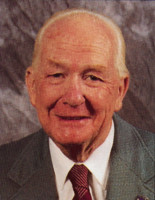
About UsThe Numismatic Bibliomania Society is a non-profit organization promoting numismatic literature. For more information please see our web site at coinbooks.org SubscriptionsThose wishing to become new E-Sylum subscribers (or wishing to Unsubscribe) can go to the following web page link MembershipThere is a membership application available on the web site Membership Application To join, print the application and return it with your check to the address printed on the application. Membership is only $15 to addresses in the U.S., $20 for First Class mail, and $25 elsewhere. For those without web access, write to: David M. Sundman, Secretary/TreasurerNumismatic Bibliomania
Society AsylumFor Asylum mailing address changes and other membership questions, contact David at this email address: dsundman@LittletonCoin.com SubmissionsTo submit items for publication in The E-Sylum, just Reply to this message, or write to the Editor at this address: whomren@coinlibrary.com
BUY THE BOOK BEFORE THE COINYou won't regret it! |
- WAYNE'S WORDS: THE E-SYLUM NOVEMBER 25, 2012
- CHARLES DAVIS DECEMBER 1, 2012 SALE REMINDER
- KOLBE & FANNING BLACK FRIDAY SALE REMINDER
- PROMOTION ON THE PUBLICATION OF THE 150TH MONETA VOLUME
- NEW BOOK: THE BATTLE FOR THE BOOKS
- PETER BERGHAUS (1919-2012)
- E-SYLUM READERS REMEMBER RUSS RULAU
- MORE ON THE 1776 CONTINENTAL CURRENCY COINAGE
- NOTES FROM E-SYLUM READERS: NOVEMBER 25, 2012
- MORE ON THE SHIP OF GOLD FILM
- QUERY: INFORMATION ON HENRY A. MERTON SOUGHT
- QUERY: HOW TO HIGHLIGHT A WATERMARK FOR DISPLAY
- NOVEMBER 2012 BALTIMORE COIN EXPO REPORTS
- ARTICLE ADDRESSES METAL ORE 'FINGERPRINTS' IN COINAGE
- QUERY: BOOK ON COIN METALS SOUGHT
- THE OMEGA COUNTERFEIT 1882 THREE DOLLAR GOLD
- URSULA KAMPMANN ON NUMISMATIC NORTHERN SPAIN
- ROYAL MINT GUIDE TO STORING AND CARING FOR MEDALS
- HOWARD DANIEL: BACK IN VIET NAM WITH OLD FRIENDS
- NEW ENGLAND SIXPENCE AUCTIONED FOR $430,000
- BURIED TREASURE, UNBURIED
- WORKERS STRIKE GOLD IN CALIFORNIA BASEMENT
- ODORS LEAD POLICE TO COUNTERFEITERS
- BANKNOTE COUNTERFEIT ZINFANDEL WINE
- SANTIAGO MONTOYA'S MONEY-INSPIRED ART
- FEATURED WEB PAGE: THE ENIGMA OF "LIMA"
WAYNE'S WORDS: THE E-SYLUM NOVEMBER 25, 2012

New subscribers this week include Dr Ali Mehilba, courtesy of Joe Boling, and Hugh Yeo of Australia. Welcome aboard! We have 1,607 email subscribers, plus 199 followers on Facebook.
This week we open with literature sale reminders from Charlie Davis, David Fanning, and Georges Depeyrot and a new book about a great resource for researchers, Google Books.
Other topics include the late numismatists Peter Berghaus and Russ Rulau, the Ship of Gold movie, an Omega counterfeit, displaying watermarked paper, and lost and found numismatic and precious metal treasures.
To learn more about World Coins magazine, the Big Silver Melt, the Potato Field New England Sixpence, and Banknote Wines, read on. Have a great week, everyone!
Wayne Homren
Editor, The E-Sylum
CHARLES DAVIS DECEMBER 1, 2012 SALE REMINDER
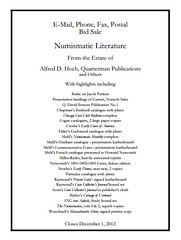 Our current sale of numismatic literature closes this Saturday December 1. The catalogue has been posted on our site at www.numisbook.com Featuring consignments from the estate of Alfred Hoch (Quarterman Publications), the sale offers research material on colonials, Ted Naftzger’s leatherbound Newcomb on the Cents of 1801, 1802, 1803, a complete set of Scott’s Coin Collector’s Journal in publisher’s cloth, Bushnell, Gschwend and Parmelee catalogues with plates, three deluxe leather bound Mehl publications and a never seen before Bowers & Merena catalogue. Numerous scarce works on classical coinage are present as well and are headed by a finely bound original set of SNG von Aulock. Nearly 300 photographs of the lots are posted at
www.charlesdavisnumismatics.com
Our current sale of numismatic literature closes this Saturday December 1. The catalogue has been posted on our site at www.numisbook.com Featuring consignments from the estate of Alfred Hoch (Quarterman Publications), the sale offers research material on colonials, Ted Naftzger’s leatherbound Newcomb on the Cents of 1801, 1802, 1803, a complete set of Scott’s Coin Collector’s Journal in publisher’s cloth, Bushnell, Gschwend and Parmelee catalogues with plates, three deluxe leather bound Mehl publications and a never seen before Bowers & Merena catalogue. Numerous scarce works on classical coinage are present as well and are headed by a finely bound original set of SNG von Aulock. Nearly 300 photographs of the lots are posted at
www.charlesdavisnumismatics.com
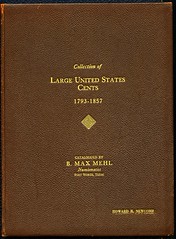
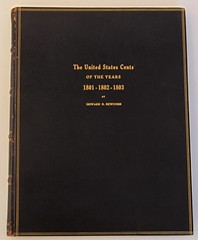
Charles Davis
Numismatic Literature
P.O. Box 547
Wenham, MA 01984
Tel: (978) 468 2933
Fax: (978) 468 7893
To read the earlier E-Sylum article, see: CHARLES DAVIS NUMISMATIC LITERATURE SALE CLOSES DECEMBER 1, 2012 (www.coinbooks.org/esylum_v15n46a04.html)
KOLBE & FANNING BLACK FRIDAY SALE REMINDER
 Kolbe & Fanning wish to remind everyone that their week-long Black Friday sale continues on the
www.numislit.comwebsite until this Friday, Nov. 30. All items are 20% off, with $5 flat rate domestic shipping for any size order (foreign orders ship at cost, as usual). Nearly 1000 items are listed on the K&F website, so be sure to check it out today!
Kolbe & Fanning wish to remind everyone that their week-long Black Friday sale continues on the
www.numislit.comwebsite until this Friday, Nov. 30. All items are 20% off, with $5 flat rate domestic shipping for any size order (foreign orders ship at cost, as usual). Nearly 1000 items are listed on the K&F website, so be sure to check it out today!
In addition, Kolbe & Fanning have been running daily specials on their Facebook page for the duration of the sale. These specials are available only to K&F Facebook friends, so go to www.facebook.com/pages/Kolbe-Fanning-Numismatic-Booksellers/152204408141576?ref=mf and "like" us today.
To read the earlier E-Sylum article, see: KOLBE & FANNING HOLD WEEK-LONG “BLACK FRIDAY” SALE (www.coinbooks.org/esylum_v15n48a05.html)
PROMOTION ON THE PUBLICATION OF THE 150TH MONETA VOLUME
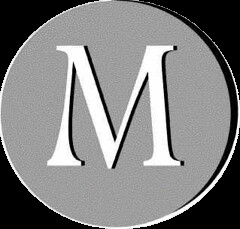 COLLECTION MONETA, Wetteren (Belgium)
COLLECTION MONETA, Wetteren (Belgium)
11 groups of promotions (up to January 31) to celebrate the publication of the 150th volume. Details on MONETA (www.moneta.be)
(# 1) HISTOIRE DE LA MONNAIE DES ORIGINES AU 18E 3 volumes (150 -> 100 euros)
(# 2) NUMERAIRE CELTIQUE 8 volumes (630 -> 400 euros)
(# 3) TRAJAN ET MARC AURELE 5 volumes (350 -> 250 euros)
(# 4) NUMERAIRE MEROVINGIEN 5 volumes (345 -> 250 euros)
(# 5) ARMENIA 7 volumes (525 -> 350 euros)
(# 6) GEORGIA 5 volumes (330 -> 250 euros)
(# 7) ROUMANIE 15 volumes (1065 -> 700 euros)
(# 8) CH. GOMEL 6 volumes (330 -> 250 euros)
(# 9) 19th C. MONETARY HISTORY, INTERNATIONAL MONETARY CONFERENCES, 4 volumes (265 -> 200 euros)
(# 10) 19th C. MONETARY HISTORY, JAPAN AND CHINA 7 volumes (475 -> 300 euros)
(# 11) 19th C. MONETARY HISTORY, FRANCE, 7 volumes (810 -> 600 euros)
For more details on MONETA, see: www.moneta.be/pages/10_promotions.html
NEW BOOK: THE BATTLE FOR THE BOOKS
 Roughly a decade ago, Google hatched an audacious plan: The company would scan the world’s books and make them searchable. But by the time Google Books officially launched in 2004 (as Google Print), authors, publishers and others had already started to voice their concerns.
Roughly a decade ago, Google hatched an audacious plan: The company would scan the world’s books and make them searchable. But by the time Google Books officially launched in 2004 (as Google Print), authors, publishers and others had already started to voice their concerns.
By definition, there is no market for millions of forgotten, out-of-print books; their contents offer endless opportunities for personal enrichment, but no equivalent financial richness. Scanning the world’s books presented, at best, a negligible business opportunity along with some very foreseeable legal headaches. So why did Google bother?
A good source on why Google does what it does is Stanford professor Terry Winograd, who supervised Larry Page’s doctoral studies and worked with both Google founders on the school’s Digital Library Project. Inside Winograd’s office in Stanford’s computer science building, shelves groaned with books, which, according to Winograd, are a technological obsolescence for others in the department.
Winograd is a quiet, mustached man with fluffy hair and a kind demeanor who is renowned for his pioneering work in artificial intelligence. There was little romantic in Winograd’s description of the genesis of the audacious book-scanning plan. He portrayed a project born equally of scholarly idealism and a cold, futuristic determinism. “It’s an idea Larry and Sergey had from the very beginning. It’s an idea that there’s knowledge out there,” he recalled. “It’s the intellectual, technological imperative.” Winograd would later repeat this phrase several times when describing how the Google founders see the world.
Multiple sources directly involved in the project confirmed that the push to scan the world’s books was not just one of the myriad eccentric projects (from driverless cars to a Mars map website) that constantly spring up all over Google. The book project was special.
“It came straight from Larry and Sergey,” said an author who took part in the negotiations between Google and the Authors Guild. “This is a project top management stayed close to and made clear that they wanted it done.”
While the Google founders’ determination to scan books is apparent, the personal motives of Brin and Page were less clear. Critics have pointed to the book scheme as proof the founders are greedy or power-hungry. New Yorker writer Ken Auletta and author of the book Googled, for instance, suggested the book scanning was simply pathological. In a 2010 phone interview, he explained to me, “They were just thinking as engineers do — Wouldn’t it be cool if we could do that? They’re not businessmen. They’re cold engineers.”
Others have been harsher, suggesting that the Google founders’ decision to scan books without permission amounts to a type of technological barbarism rooted in a lack of culture or literary savoir faire.
Such caricatures are neither fair nor accurate. Winograd dismissed them by pointing out that both Page and Brin were raised in academic families that valued books and libraries.
As for Page and Brin themselves, they don’t seem to have cared whether the world thought they were visionaries or villains. They had a task to accomplish. As Winograd said, “I think if you ask them, [they’d say] this is going to get done, even in five years. This is the technological imperative — information must be searchable. They’re often more in tune to the technological imperative than to social barriers. To them, social barriers are transient.”
The authors and publishers who eventually sued Google over the book scanning would likely chafe at the notion that they are “transient social barriers,” but the Google founders’ attitude was not altogether unreasonable. A new technology had made it possible to create a vast library of the world’s books, so what was everyone waiting for?
With this mix of insouciance and technological urgency, Brin and Page began to put their grand plan into place.
To read the complete article, see:
The Technological Imperative An Excerpt From The Battle For The Books
(gigaom.com/2012/11/21/the-technological-imperative-an-excerpt
-from-the-battle-for-the-books/)
THE BOOK BAZARRE
PETER BERGHAUS (1919-2012)
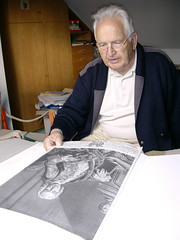 On November 16, 2012 Peter Berghaus died just four days before his 93rd birthday. Even during his last months he was keeping his mind alive. With him we have lost one of the most eminent numismatists of Europe whose cooperative character strongly influenced the world of collectors and researchers.
On November 16, 2012 Peter Berghaus died just four days before his 93rd birthday. Even during his last months he was keeping his mind alive. With him we have lost one of the most eminent numismatists of Europe whose cooperative character strongly influenced the world of collectors and researchers.
Thinking of Peter Berghaus I feel again affected by the fear I felt once preparing a paper I intended to read at the coin collectors’ convention in Minden. Incorruptible, they called Peter Berghaus. When he spotted an error, he always called your attention on that point, even in front of all the listeners. And he did so with all referees indiscriminately, with world renowned professors or a novice like me at that time. Actually, Peter Berghaus was more than friendly with me. He didn’t use any of these simulated commonplace phrases and clichés. No, he discussed with me at an eye level. But he did so not only with me. Peter Berghaus was, indeed, one of the great teachers of numismatics who was able to rejoice at the achievement of others. He took seriously innumerous people and stimulated all those who loved coins like him and wished to research into them, young students and advanced collectors alike.
Peter Berghaus was born on November 20, 1919 in Hamburg being the youngest of four children. How to summarize his childhood and youth? He lost his parents when he still was young. And, naturally, he started collecting, when he was a schoolboy attending the Johanneum whose long tradition went back until 1529. Of course, he did not just collect coins like many of us have done. Peter Berghaus focused on countermarks. And thanks to that he was accorded the honour of being admitted into the circle of the numismatic association of Hamburg ‘Hamburger Münzfreunde’ when he was only 18 years old. Thinking of today’s coin associations and how they are glad about every new young collector, one cannot appreciate it too much. In 1937 this association was frequented only by well heeled elderly gentlemen like Friedrich Bonhoff or Bruno Dorfmann who demanded two guarantors before allowing the new member to attend their meetings. After all there were coins lying on the table which equaled to an average weekly worker’s revenue.
Neither Peter Berghaus was spared the military service. Nearby Würzburg he was wounded so severely on April 5, 1945, that he lost his left forearm. After the war he took up his university studies. Walter Hävernick, who was director of the museum of Hamburg’s history at the epoch, became his teacher.
Peter Berghaus did a PhD with a methodically innovative research entitled ‘Currency frontiers of the territory of the Upper Weser in Westfalia in the late Middle Ages.’ Then everything went quickly. In 1949 he completed training at the coin cabinet of the museum of Hamburg’s history. In the following year, 1950, he joined the Westfälisches Landesmuseum für Kunst und Kulturgeschichte in Münster which he was in charge of as a director between 1977 and 1984. Contemporarily he supervised the numismatic juniors at the Westfälische Wilhelms-Universität.
In 1951 he was Spiritus Rector of the coin collectors’ association of Westfalia and the neighbouring territories. Between 1972 and 1992 he was vice president of the German Numismatic Association (Deutsche Numismatische Gesellschaft). And in 1979 he was elected Vice President of the International Numismatic Commission.
We could continue nearly forever because virtually every collector or researcher of a certain generation knows some story about how they met this significant man. We all have taken so much from Peter Berghaus that there is just one thing we can do according to his principles: passing on the knowledge to colleagues, collectors, students, and all those who can enjoy the stories coins are telling.
To read the complete article, see: Peter Berghaus (1919-2012) Medal on the Occasion of Dr Peter Berghaus' 80th Birthday 1999 (www.coinsweekly.com/en/News/4?&id=1605)
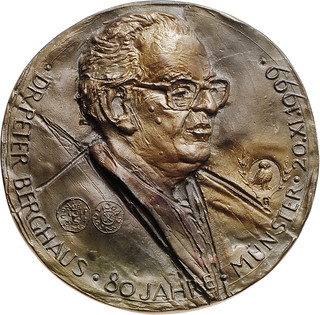
For an obituary at the German Society of Arts Medals, see: http://www.medaillenkunst.de/index.php?item_id=644 (www.medaillenkunst.de/index.php?item_id=644)
For more background on Peter Berghaus and his numismatic writing, see the German Wikipedia page: Peter Berghaus (de.wikipedia.org/wiki/Peter_Berghaus)
E-SYLUM READERS REMEMBER RUSS RULAU
Affectionate regards for Russ Rulau! We shall not see another like him for a very long time.
Joe Boling writes:
Rulau's obituary states, "He often stated the high point of his service came July 30, 1945 when he was assigned to General Macarthur's arrival honor guard from among the first combat troops to reach Japan at Atsugi Field the evening before. "
Russ Rulau may have been assigned to the honor guard on 30 July, but he was not at Atsugi until the end of August. On 30 July we were still bombing Japan.
Dave Alexander writes:
The recent obituaries of Russ Rulau appear to downplay his role in assuring the launch of modern world coin collecting in the U.S. through the monthly magazine "World Coins," published 1964 through early 1976. It would be difficult to overstate the significance of this monthly magazine which brought in-depth, accurate, up to date research articles, news of new issues, hobby figures, organizations, happenings and all the rest.
When Russ left Amos Press to join Krause Publications, it was expected that he would build up the anemic "World Coin News" tabloid to something of comparable quality. This failed to happen. "World Coins" magazine was the victim of a very short-lived rogues' alliance between "Coin World" editorial and advertising (ordinarily rivals in the best newspaper tradition).
The CW editor eliminated the last pocket of independence in Amos Press (presided over by Russ Rulau's successor Courtney L. Coffing). Advertising cut its staff workload by 2/3 ("Numismatic Scrapbook" was eliminated at the same time, David T. Alexander, Executive Editor). The plan was that advertisers in "World Coins" would now be bludgeoned into paying vastly more to advertise in the new "Coin World International" feature or perish. Many perished and a great deal of damage was done to the world coin market.
Russ described the annihilation of "World Coins" to me as "a criminal act," as indeed it seemed to so many. I treasure my bound set of "World Coins" that reposes in green library buckram behind my work desk.
Rulau's book ventures deserve more recognition that the obits suggest. His revival (with George Fuld) of William Spohn Baker's "Medallic Portraits of Washington" deserves the applause of a generation. It went through two editions and while the decision to preserve Baker numbers at all costs was not fully compatible with modern presentation of the actual material, Baker remains the only reference worth citing in its field.
"Discovering America, the Coin Collecting Connection" brought a wealth of material from the most scattered sources to collectors but never got the recognition it should have received. For one thing, it brought much of the late Nathan Eglit's incoherent Columbiana listing back to collector accessibility.
Bibliophiles may be surprised to learn that while Krause Publications always boasted of its pioneering of computer technology in book publishing, Russ would have none of it, telling me before his death that he maintained his typed or hand-written research data on Washingtoniana on file cards!
David L. Ganz writes:
I was saddened to hear about Russ Rulau's death. I have a number of memories of him, but here's one that I'll share.
In March 1972: Interviewing Mary T. Brooks, director of the Mint. (I interviewed Mrs. Brooks many times over her tenure in office as Krause Publication's Washington correspondent. As I often point out, I was Burnett Anderson before he was.) At that meeting, I asked her about what seemed very logical to me, a gold coin for the bicentennial, paralleling the sesquicentennial issue of 1926. Her verbatim response – which you didn't read in Numismatic News in May, 1972: "I'd love to strike a gold bicentennial coin. No more wonderful way could be found to commemorate our bicentennial than with a gold coin."
Later that day, a staff member who was present at the interview– Roy Cahoon– called me at home and requested that the remark be left unpublished – evidently the Treasury Secretary heard about it and decided it would roil the gold market if the Mint director were heard advocating gold coinage.
For real! I understand economics and this could be a consequence, so the story gets spiked. A month later, my competitor on topics relating to gold, Russ Rulau, publishes a similar interview that he held with Mrs. Brooks in Numismatic Scrapbook, also a competitor. Except that he expands upon it with her! The international monetary system survived, and we got no gold coinage for a few more years.
Russ was a newspaper competitor, and a fierce on at that, but he got the results fair and square. And I kidded him about it for years.
To read the earlier E-Sylum article, see: RUSSELL RULAU 1926-2012 (www.coinbooks.org/esylum_v15n48a07.html)
MORE ON THE 1776 CONTINENTAL CURRENCY COINAGE
Last week Andrea Grimason shared a summary of her theory on the creation of the continental currency coins. In summary, she believes that:- Benjamin Franklin designed and made the original coins at the Soho Mint in 1776
- There was at least one coin made of copper
- At least one copper coin was plated with silver
- None were made of pure silver
- The coins struck in pewter and in a collar were made years later
John L. (Jack) Howes writes
I expect you may get quite a few comments about this theory. Hard to decide where to start. I guess my main problem is that there are a number of factual errors:
1) The Soho mint did not exist in 1775 (not created until 1788),
2) Silver continental dollars do exist (3 or 4), and
3) Although I am not an expert on them, I have never heard of a silver coated copper one.
Dick Doty concurs with the first point. He writes:
A slight difficulty with the latest Continental Dollar explanation: the Soho Mint wasn't begun until 1788, didn't strike its first money till the late summer of the following year.
Andrea Grimason responds:
Boulton was active before 1788. He had been making medals and coin weights since 1775. The original coins were made on Boulton's property in Soho, but they were not made on the new machines at the mint - they were hand made.
Jack writes:
I would like to see a good quality image of this silver coated copper specimen. Does such an image exist? If the image does not rule the coin out immediately, I am sure I can find someone to do a surface XRF analysis.
Jack also provided some great background information from Heritage lot descriptions. Here's a nice summary of Eric Newman's theory of the origin of these pieces:
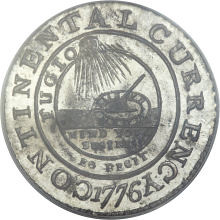 Newman observed that the design of the Continental coinage used identical design motifs as found on the February 17, 1776, issue of Continental Currency fractional notes. Newman wrote:
Newman observed that the design of the Continental coinage used identical design motifs as found on the February 17, 1776, issue of Continental Currency fractional notes. Newman wrote:
"There is no doubt that all of the varieties of the coinage were made by the same diemaker, and it is fortunate that the initials EG were placed on one variety (3-C). "There was no other avenue of research than to begin by looking for a qualified person with those initials. It was a pleasant surprise, therefore, to find that in 1776 there lived an American engraver by the name of Elisha Gallaudet. Merely naming him without supporting data would satisfy no one even though no other qualified person with the initials E.G. could be found. Thus, research to prove or disprove that theory was undertaken."
At the end of his 12-page article providing substantive evidence, Newman summarized the facts that related to his conclusion that "EG" was Elisha Gallaudet. The following were his points:
1. Elisha Gallaudet was the only engraver with initials E.G. in 1776.
2. He was considered trustworthy in Treasury matters.
3. He engraved Colonial paper money for the Colony and City of New York.
4. His nephew, Peter Wallace Gallaudet, was well-connected in Philadelphia
5. Dies indicate the work of an engraver rather than a die-sinker.
6. He was an engraver but inexperienced in die-sinking.
7. He was known to his family as the man that "prepared the first United States coin."
http://coins.ha.com/c/item.zx?saleNo=1173&lotNo=5006
Table of rarity of die varieties and different metals:
Hodder Newman Composition Rarity Comments
1-A.1 1-A Brass Three known Bowers reversed the rarity of this and the next
1-A.2 1-B Brass Low R.7 Hodder estimates 10 to 12 known
1-A.2 1-B Pewter Three known Unknown to Newman
1-A.3 1-C Pewter Common Perhaps 400 to 500 exist
1-A.3 1-C Silver Two known Intermediate die stage
2-A.3 2-C Pewter Common Perhaps 300 to 400 exist
3-B 3-D Pewter Common Perhaps 300 to 400 exist
3-B 3-D Silver Two known
4-B 4-D Pewter Four known
4.1-B 5-D Pewter Three known
http://coins.ha.com/c/item.zx?saleNo=1173&lotNo=5006
Jack writes:
The minting sequence of these has been determined. This is from Heritage (not sure who wrote it but I checked this order from the images I have collected (about 100) and concur):
Continental Dollar Die States and Production Order
Among many numismatic pleasantries is the determination of the order that a series of coins were produced, commonly called the emission sequence. For the Continental Currency coinage, several observations will assist the study. We know that just two reverse dies were used for the entire series with a convenient break that provides two distinct groups. Reverse A exists in three stages, so we can be certain that the varieties were struck in order as 1-A.1, 1-A.2, and 1-A.3. The obverse of 1-A.3 exists in a number of die states, so that sequence can be further fine tuned. The development of rust marks on the reverse of variety 2-A.3 informs us that it was the last variety produced with the first reverse die.
The second reverse was used to produce three varieties from two obverse dies. This reverse has a prominent die crack curving through many of the rings, and stages of the crack help us determine the striking order. On variety 3-B, the crack begins in ring 13 (Georgia) and continues clockwise through eight additional rings, terminating in the Delaware ring. Two examples variety 3-B in the present sale are entirely different die stages. The PCGS MS64 example is in the die stage just described, while the MS63 NGC piece is a much earlier die stage with an intermittent crack that misses some of the rings. The Ornamented Date coin, variety 4.1-B, is in a similar stage with the earlier state of 3-B. Michael Hodder studied the die states extensively, and determined the emission sequence of the second group as 3-B, 4-B, 3-B, 4.1-B, and 3-B.
A further complication in the development of an emission sequence is where to put the off metal brass and silver pieces. The brass pieces were struck before and simultaneously with the pewter coins. The silver pieces from Reverse A were coined between intermediate and late states of 1-A.3, and the silver pieces of Reverse B were coined simultaneously with the first pewter examples of variety 3-B.
The two groups of varieties are unconnected, meaning there is no single obverse die that was used with both reverse dies. Hodder pointed out that there is no common punch used on both reverse dies. However, the geographical relationship of the rings on the blundered Reverse A, and the corrected Reverse B almost ensures that Reverse A was used first. The emission sequence of the Continental Currency coinage follows closely the sequence that Hodder presented in his 1991 article.
Group One - Reverse A
Sequence Hodder Newman Composition Comments
1 1-A.1 1-A Brass
2 1-A.2 1-B Brass and Pewter
3 1-A.3 1-C Pewter Early and Intermediate States
4 1-A.3 1-C Silver Intermediate State
5 1-A.3 1-C Pewter Intermediate and Late States
6 2-A.3 2-C Pewter
Group Two - Reverse B
7 3-B 3-D Pewter and Silver
8 4-B 4-D Pewter
9 3-B 3-D Pewter
10 4.1-B 5-D Pewter
11 3-B 3-D Pewter
http://coins.ha.com/c/item.zx?saleNo=1128&lotNo=1006
To read the earlier E-Sylum article, see: GRIMASON'S THEORY ON THE 1776 CONTINENTAL CURRENCY COINAGE (www.coinbooks.org/esylum_v15n48a11.html)
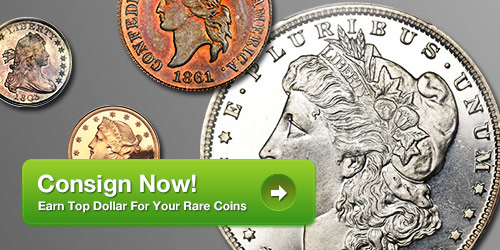
NOTES FROM E-SYLUM READERS: NOVEMBER 25, 2012
Comments on American Numismatic Biographies
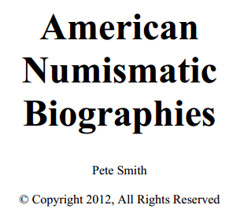 Regarding Pete Smith's update to American Numismatic Biographies, Darryl Atchison of Ireland writes:
Regarding Pete Smith's update to American Numismatic Biographies, Darryl Atchison of Ireland writes:
What another monumental publication! Pete deserves our admiration and respect for keeping this updated.
To read the earlier E-Sylum article, see: SMITH'S AMERICAN NUMISMATIC BIOGRAPHIES UPDATED (www.coinbooks.org/esylum_v15n48a04.html)
Contact for Frank Draskovic and SOCALOMS
Joe Boling and Frank Draskovic noticed that I forgot to include Frank's email address in last week's item on Southern California Orders & Medals Society (SOCALOMS). Oops! The sentence should read:
All we ask is that a guest contact us first so we know who's walking in the door and they can do that by emailing me at fdraskovic@hotmail.com
To read the earlier E-Sylum article, see: THE SOUTHERN CALIFORNIA ORDERS & MEDALS SOCIETY (www.coinbooks.org/esylum_v15n48a09.html)
The Gold Erie Canal Medal
John W. Adams writes:
The gold Erie Canal medal that was knocked down for $156,000 has attracted comments like: "The buyer needs a saliva test". Perhaps so, but perhaps not. In the 1925 sale of the fabled W.W.C. Wilson collection, a gold Erie Canal fetched $460 whereas a 1766 Happy While United medal was knocked down for $360 and a Washington oval peace medal for $210. If offered today, either one of these classics would bring more than $156,000.
To read the earlier E-Sylum article, see: JOHN QUINCY ADAMS GOLD ERIE CANAL COMPLETION MEDAL SOLD (www.coinbooks.org/esylum_v15n47a19.html)
MORE ON THE SHIP OF GOLD FILM
There was a 50 min documentary made by the History Channel in 2009, which is available for sale. History's Mysteries: Ship Of Gold (www.amazon.com/Historys-Mysteries-Ship-Of-Gold/dp/B000WKWBBY)
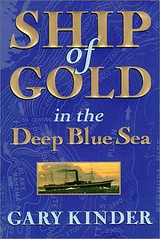 But, there is another film in development. This is from the Monday (November 19, 2012) New York Times:
But, there is another film in development. This is from the Monday (November 19, 2012) New York Times:
Ship of Gold in the Deep Blue Sea
Alternate title: Ship of Gold
Production Credits
- Director - Doug Liman
- Screenplay - Gary Kinder
- Source Material - Gary Kinder
- Executive Producer - David Bartis
- Executive Producer - Alison Greenspan
- Producer - Denise Di Novi
Company Information
- Di Novi Pictures - Production Company
To read the complete article, see: Ship of Gold in the Deep Blue Sea (movies.nytimes.com/movie/440283/Ship-of-Gold-in-the-Deep-Blue-Sea/credits)
To read the earlier E-Sylum article, see: QUERY: WILL 'SHIP OF GOLD' BECOME A FILM? (www.coinbooks.org/esylum_v15n48a20.html)
QUERY: INFORMATION ON HENRY A. MERTON SOUGHT
Web site visitor Michael Chazin writes:
I was looking for information on Henry A. Merton who wrote the Big Silver Melt book that is highly sought after by collectors, etc. I saw mention of some article that ran in your publication back in 2006 on the subject of the silver melt.
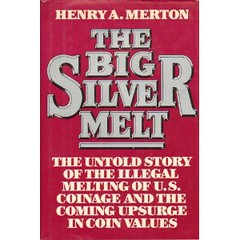 I am trying to find out if any of Merton's conclusions about the numbers of extant coins ever gained any traction in the marketplace. If you look at the Guide Book it doesn't appear that anyone takes him too seriously. Yet I wonder.
Is Merton still alive?
I am trying to find out if any of Merton's conclusions about the numbers of extant coins ever gained any traction in the marketplace. If you look at the Guide Book it doesn't appear that anyone takes him too seriously. Yet I wonder.
Is Merton still alive?
This book chronicled the events of the silver price run up and the unsuccessful attempt by the Hunt Brothers to corner silver. Of course there were some dramatic events after the book was published, like the auction sale of the Hunt’s notable ancient coin collection (and the ultimate sale of so much of their assets).
I hope this book is the source of the story I have repeated often. The Hunts took possession of tons and tons of silver and wanted to get it to Europe. How? They flew their ranch hands (read gun-toting cowboys) to New York. Picked up the silver at a refinery in New Jersey. Drove it to Kennedy International with the ranch hands riding shotgun over all that silver. They oversaw it loaded onto a plane, climbed aboard and flew it off to Belgium, I believe. The shotgun delivery protected the other end, as well.
Merton’s book is excellent; recommend for E-Sylum readers.
To read the earlier E-Sylum article, see: THE GREAT SILVER MELT – MAKE THAT THE ‘BIG’ SILVER MELT (www.coinbooks.org/esylum_v09n19a10.html)
QUERY: HOW TO HIGHLIGHT A WATERMARK FOR DISPLAY
Dick Hanscom writes:
I want to display a note with a watermark, but I need to do something so that the watermark is visible without a light behind it. In short, the watermark must be permanently visible. I was hoping the readers of The E-Sylum might have an idea. Permanent damage is not a problem.
I have a sheet of banknote paper recovered from the wreck of the Breda. I am making a display of my shipwreck items, and I want to include this, but without the watermark showing, it is just a piece of paper.
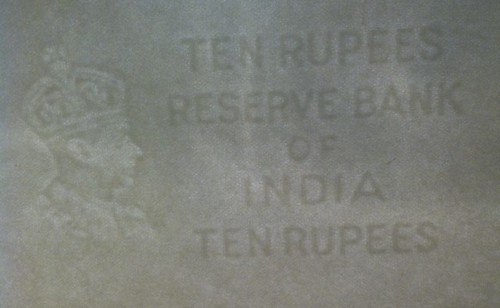
On 23rd of December 1940, two German Heinkel bombers attacked a convoy of British ships awaiting in Ardmucknish Bay, Benderloch, near Oban in Scotland. Among the damaged vessels was a Dutch ship, the S.S. Breda. Built in 1921, Breda was 400 feet long and weighed about 7,000 tons. Bound for India to help build an air strip, her manifest included Tiger Moth motorcycles, cement, leather and a Rolls Royce. As they tried to tow her to safety, she listed and sank, with her masts still well above water. For years, divers practiced on her, as she was a well known shipwreck. Later, the masts had to be cut off to alleviate the obstruction to shipping.
The S.S. Breda lay there, dived on, but in many ways undiscovered because of the darkness of the loch. Then the Tralee Bay Diving and Watersports Club made a most amazing discovery. In one of the long hidden cargo holds was found the remains of paper, but not just any paper can survive 50 years under water. This was fine quality paper used for the printing of banknotes! Portals, who was owned by the Bank of England, had manufactured special paper for the printing of Indian banknotes, watermarked with the portrait of King George VI. The wooden boxes had been eaten away and the edges of the uncut sheets were a little ragged, but this treasure was still intact!
This banknote paper is an authentic relic of that shipwreck. It was originally destined to become an India ten rupee banknote. The water mark shows a likeness of King George VI, the denomination and the words, “RESERVE BANK OF INDIA”
To read the complete article, see: Watermarked Paper Money from British India : SS Breda (www.cointalk.com/t199708/)
NOVEMBER 2012 BALTIMORE COIN EXPO REPORTS
Michael Sullivan writes:
Overall, I the show was well attended by dealers and collectors alike. The bourse was busy. From a literature perspective, both Charlie Davis and John Burns had tables with stock for sale. Charlie brought along a selection of lots from his December auction for viewing. Len Augsberger was viewing lots as I arrived at the table mid-day on Friday.
A highlight of the show was a selection of "Cardinal Collection" lots available for viewing by StacksBowers. The 2013 offering includes high grade coppers, a mint state 1794 dollar, and many other numismatic treasures.
As usual, the best part of the show was seeing people with whom I've built personal relations over the last 29 years of collecting.
Just back from Baltimore and a few hours of getting reacquainted with my recliner. I had a blast! Where to start... I guess at the beginning. I drove to Baltimore Thursday AM and entered the convention early with the dealers, to set up the C4 Area. Jim Rosen and Jack Howes had beaten me there! We had a very nice area with 4 tables to congregate, 5 exhibit cases and located right next to the auction lot viewing areas - a perfect location There was always a small crowd in the C4 area.
Will Nipper was in charge of C4 Exhibits this year and we had three on display. David M had a beautiful two case exhibit of Franklin Material. I've always loved the Nini portraits - someday I'll need to get me one! Will N had a two case exhibit of Nova Constellatio with all the varieties on display. Both of these exhibits looked like they were professionally done.
The third exhibit was a one case display of colonial bills. It had a Continental Currency piece and a bill from each of the 13 colonies. It was simple and the material told the story.
Jeff Lipsky was in charge of C4 Education and had a wonderful program lined up. As always, there is something that doesn't go according to plan.. A couple days before the convention we discovered our featured speaker, Harvey Stack, was unable to attend due to family issues. But in his place, Jim Rosen gave a presentation on the Continental Dollar and Jack Howes gave a presentation on the "Ryder 40" Vermont. Both were well received.
These presentations were followed by the scheduled talks. Jack Howes & Buell Ish talked on the long awaited NJ Copper Magnum Opus. Their PowerPoint presentation was very informative and I can't wait for the book! Jim Jones was to give a presentation at a past C4 Convention but had passed away a month or so before. His family had the presentation in PowerPoint and in his memory, John Kraljevich presented it to the members as our final talk. Now, those that know John also know he can make a Lincoln cent sound interesting! Just imagine what he did with this Comitia Americana talk!
Being that we had just one night (instead of the two we had in the past) for both the C4 Reception and our Educational Forum, both events were held in the same room in the Sheraton Hotel. It was just the right size and I personally thought the food was better than Boston. There was also a C4 member who anonymously (and secretly) purchased another jumbo shrimp platter for the evening. Thank You!!!
Dennis Wierzba has been our Convention Chairman for 18 years, and did an outstanding job organizing this event in a totally new venue. Everything seemed to run like clockwork! The C4 Auction was a part of the Friday night Stack's Bowers Auction. It started at 6:00 PM and lasted until about 3:00 AM Eastern Time! I didn't last that long! I stayed through the end of the Rob Retz Fugios and left with Craig McDonald to walk back to the Hotel about 1:45 AM. I did get a couple of Rob's Fugios for my collection. Our thanks to Jim Rosen and the Stack's Bowers people for making this happen. The people at Stack's Bowers, and at Whitman, were just the nicest people to work with. Jim and Dennis can tell you.
Being that we were at a convention where there were thousands of collectors attending, C4 arranged to have three educational presentations at the convention for the general public (and C4 people too). The first one was supposed to be Roger Siboni talking on "The History of Colonial America Told Through Its Coinage". As many know, Roger was affected by Hurricane Sandy and was very disappointed to not be able to attend. Will Nipper stepped to the plate and gave a presentation using the same title. Will's talk was very well done and well attended too. It was videotaped and hopefully a copy will be in the C4 Library in a month or two.
I gave two talks geared for the general public, one on collecting colonial paper money and the other on collecting the state copper coinages. I hope that both talks were as fun for the attendees as they were for me.
Both Buell's wife (Angie) and my wife (Diane) arrived on Friday. The four of us had a very nice time having dinner at Bubba Gump's on Saturday night. Jack Howes joined us and we had so much fun talking that we didn't even notice how slow the service was. The four of us again met for breakfast this morning, where we parted company until... I'm so glad Diane has found a good friend in Angie.
I can't say enough about Jim Rosen and his part in moving C4 to the Whitman Expo in Baltimore. The membership doesn't see what goes on behind the scenes, and I only see a little. Jack Howes was with Jim every step of the way, and was also responsible for providing the C4 Program for this convention. Working with them was Dennis Wierzba and all of our C4 Board. You all have some good people placed in office, and I can say that from knowing them all personally and having worked with them in the past.
Lastly, it was fun to see some people that I haven't seen for some time (Mitch M among others), finally meeting the ex-Canadian Paul Cartmill, spending a little time with the Retz family too. The Retz women are just the nicest people. I said good bye to them, knowing that we may never meet again.

ARTICLE ADDRESSES METAL ORE 'FINGERPRINTS' IN COINAGE
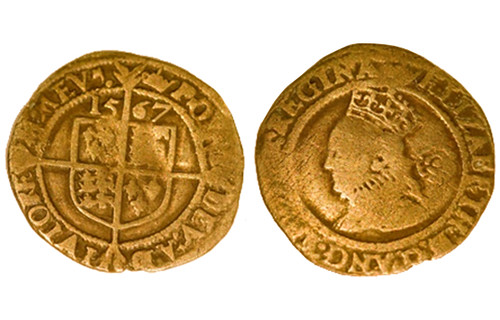 A coin struck during the reign of England’s Elizabeth I (1558–1603)
A coin struck during the reign of England’s Elizabeth I (1558–1603)
Nature has buried a lot of clues in the world if man would only learn how to read them. That is the case with ores buried underground -- and the resulting metal made from those ores -- and the products made from that metal.
Man is learning more and more how to read the "fingerprints" of metal ores. The miniscule metal impurities, found in all metal, reveal a distinctive pattern. From the measurements of these impurities, now easily obtained by modern laboratory equipment, lock in the identity of metal ore from any location. These manifestly stay in the metal through all forms of manufacture, fabrication, or movement around the globe and last for all time.
Thus scholars have analyzed ancient coins by chemical analysis of their metal to gain intelligence on where the metal came from. Scholars are building a databank of the impurity fingerprints of the metal from each original mine.
Gold is a little more obvious in its impurity identity by slight differences in color, unlike other metals. Slight amounts of silver or platinum will make a whiter gold. Copper makes gold reddish or pinkish. Iron turns gold greenish. And it was learned that it was bismuth that made a natural "black gold." All from those miniscule impurities.
We can tell which early American coins were made from blanks obtained from Mathew Boulton; he obtain his metal from Sweden's "copper mountain" in the 18th century. This in contrast to the copper colonial mints obtained from early Connecticut mines.
An article appeared this week that verifies that certain English coins were made of silver from Mexico.
Chemical studies of old English coins are helping unravel a centuries-old mystery: What happened to all the silver that Spaniards dug out of the New World?
Silver from Mexican mines started being incorporated into English coins around the mid-1550s, a new study shows. But silver from the legendary Potosí mines, in what is now Bolivia, didn't show up until nearly a century later, researchers report online November 6 in Geology.
The new study adds hard data to theories linking the transatlantic influx of silver to price inflation across Europe from about 1515 to 1650.
Minerals such as gold and silver contain a chemical fingerprint of where they were born, for instance in the composition of copper and lead that appear along with the more precious metals. Anne-Marie Desaulty and Francis Albarède of the Ecole Normale Supérieure in Lyon, France, analyzed 15 English coins, dated between 1317 and 1640, for variations in their copper, lead and silver.
Lead in all the coins before the reign of Mary I, which began in 1553, showed that the ore was at least 220 million years old, suggesting it came from ancient rocks in either central Europe or England. Lead in later coins showed a much higher contribution of silver younger than 50 million years old - suggesting it came instead from the mines of Mexico.
The coins show very little hint of Potosí silver, which has a distinctly different lead signature than Mexican ore. That's surprising, Desaulty says, because the Potosí mines were churning out far more silver at the time than Mexico was.
Geography may explain this, she says: It was easier to ship Mexican silver eastward to Europe than to get Potosí silver across the breadth of Brazil. Instead, Potosí silver went west, from Lima to Acapulco and onward to markets in China.
Scholars have known of this westward trade route before, which probably didn't become really important until the early 17th century, says John Munro, an economist at the University of Toronto.
To read the complete article, see:
Mexican silver made it into English coins
(www.sciencenews.org/view/generic/id/346607/title/Mexican
_silver_made_it_into_English_coins)
QUERY: BOOK ON COIN METALS SOUGHT
Coincidentally, W.J. Elvin writes:
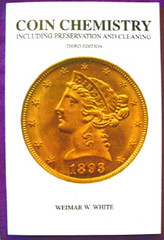 Is there a book on coin metals for the nonscientist? Searching how to identify coin metals online brings up a great deal about scrap and some rather harsh techniques, I don't think I'll be dropping a vintage medal in muriatic acid ... I liked one fellow's take on finding out if it's brass or gold: "Take it to a pawn shop." Various reference works help randomly for comparisons but it would nice to have something specific, preferably with great photos ... or maybe readers know of a web site where all this is done?
Is there a book on coin metals for the nonscientist? Searching how to identify coin metals online brings up a great deal about scrap and some rather harsh techniques, I don't think I'll be dropping a vintage medal in muriatic acid ... I liked one fellow's take on finding out if it's brass or gold: "Take it to a pawn shop." Various reference works help randomly for comparisons but it would nice to have something specific, preferably with great photos ... or maybe readers know of a web site where all this is done?
To read an earlier E-Sylum item on the Coin Chemistry book, see: NEW BOOK: COIN CHEMISTRY, 3RD EDITION (www.coinbooks.org/esylum_v15n23a06.html)
THE OMEGA COUNTERFEIT 1882 THREE DOLLAR GOLD
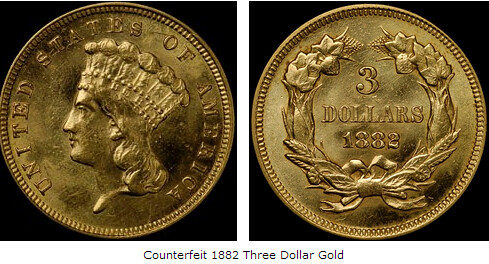
Several months ago NGC received this counterfeit 1882 three dollar.
This is the so-called Omega fake three dollar, named for the Greek letter Ω (omega) that the counterfeiter used to mark his handiwork. The Omega counterfeiter is best known for the high quality 1907 High Relief $20 fakes, but several other series were targeted including the 1882 three dollar.
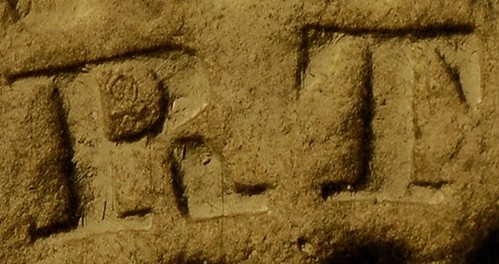
On the Omega three dollar coins, the counterfeit’s Ω signature can be seen within the loop of the R in LIBERTY. While this piece has been altered to the point where the Ω is very faint, on other counterfeits it can be quite prominent. A few other forgeries were made by the Omega counterfeiter, and all can be linked by the presence of this Greek letter. The Omega High Relief twenties are far more deceptive, but this is still an above average counterfeit.
To read the complete article, see:
COUNTERFEIT DETECTION: 1882 THREE DOLLAR GOLD PIECE
(www.ngccoin.com/news/viewarticle.aspx?IDArticle=3033
&Counterfeit-1882-three-dollar)
URSULA KAMPMANN ON NUMISMATIC NORTHERN SPAIN

Alfonso VIII, 1158-1214. Dinero, Cuenca(?)
Today we’re visiting Burgos, an important minting site of the Castilian kings. Then it’s on to Santo Domingo de la Calzada, known for the fact that its roast chickens occasionally have a tendency to come back to life!
It was freezing cold and the sun was beaming as we set off from the parador in Leon to cover yet another leg of the Way of St. James in reverse order. Our next destination was Burgos, arguably one of the most famous cities in Northern Spain.

Charles V, 1506-1555. Real d'oro, Antwerp.
Today, Burgos is still an affluent and active commercial city with a sprawling retail centre. It’s also one of the most important tourist centres in northern Spain, something that we were certainly happy about. The city centre was wonderfully signed, as was the convenient parking garage. And the cathedral was big enough that it was easy to find straight off the bat.
Burgos was founded in the year 884 by Alfonso III as one of many fortresses, or castle villages, which give the region its name: Castille. They served as a safeguard against the Arabs and, through their depiction on Castilian coins, became a symbol of the kingdom.
To read the complete article, see: Numismatic Northern Spain – Part 8 (www.coinsweekly.com/en/News/4?&id=1606)
ROYAL MINT GUIDE TO STORING AND CARING FOR MEDALS
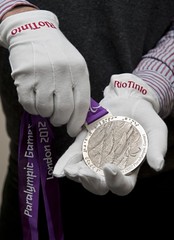 If you’ve ever won a medal, been awarded a Military or Royal Honour or own a beautiful coin, you will undoubtedly want to keep it looking as beautiful as the day you proudly acquired it.
If you’ve ever won a medal, been awarded a Military or Royal Honour or own a beautiful coin, you will undoubtedly want to keep it looking as beautiful as the day you proudly acquired it.
But now you and Usain Bolt, Mo Farah, thousands of military and civilian heroes and others have a problem in common – how to keep that precious and beautiful piece of metallic art sparkling.
Whether it’s an Olympic or Military medal or a coin, there are some common principles that apply to caring for it.
Keep the leaflet
If care instructions were included, don’t throw them away in your haste to display your pride and joy! It may be some time before you and Usain get the dusters out to restore that original sparkle, but when you do, you’re going to wonder where to start, what to use, and what could be damaging. Medals and coins are made from various metals and alloys, all of which can be damaged or enhanced by the way they are treated.
Keep the case
The original case or box is always the best place to store your treasure, but if you have it proudly on display in a cabinet, at least ensure you always carry it in its original case when transporting it anywhere. The athlete who left his Olympic medal in a taxi a few years ago was probably glad it was stored in its original case rather than being in a bag or sleeve when it was finally returned to him, undamaged.
Be careful with it
Try to avoid any sort of impact or abrasion – this may be particularly relevant in the first few hours of celebrations! The material bought to make the ribbons for the London 2012 medals was strength-tested to ensure it would resist a medal being joyously swung around. As far as is known, there were no such mishaps involving the ribbon, but the mount on one medal sheared off when it received what must have been a considerable blow when dropped in the athlete’s shower.
Be gentle with it
Whatever the metal or alloy, use only a soft, dry cloth for cleaning (preferably cotton or soft muslin). Anything else risks irrevocably scratching or marking the metal, and once done, such damage can be extremely difficult to remove, if not impossible. Your eye will go to that scratch every time you look at it…
Be kind to it
Do not use any liquids, chemicals or abrasive cleaning substances. The London 2012 Silver and Bronze medals were hand-finished with a special coating, so cannot be cleaned and probably will never need to be. The Gold medals are plated in gold, so can be cleaned with care, as above. Wiping with a water-dampened cloth to remove the dirt and oils that dull the sheen, produces a more lustrous appearance immediately; in many cases this kind of damp-wiping will be enough to restore the original shine.
To read the complete article, see:
Medals, old coins, new coins are forever, keep them beautiful forever
(blog.royalmint.com/a-medal-an-old-coin-a-new-coin-you-have-it-forever
-keep-it-beautiful-forever/)

HOWARD DANIEL: BACK IN VIET NAM WITH OLD FRIENDS
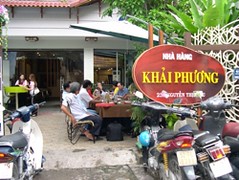 A couple of days later on Sunday morning, Oct. 7, I took at taxi to 27 Nguyen Thi Dieu Street in District 3, but right on the edge of District 1. Quoc’s shop, Saigon Coins and Stamps, is located there, and he is my primary numismatic dealer in Viet Nam. We are in constant contact via emails so there was very little to catch up on with him.
A couple of days later on Sunday morning, Oct. 7, I took at taxi to 27 Nguyen Thi Dieu Street in District 3, but right on the edge of District 1. Quoc’s shop, Saigon Coins and Stamps, is located there, and he is my primary numismatic dealer in Viet Nam. We are in constant contact via emails so there was very little to catch up on with him.
Then I walked a couple of buildings toward the District 1 line to the Khai Phuong Restaurant at 23 Nguyen Thi Dieu Street. There were about a dozen collectors already there and there were 18 by the time the meeting was over. It was great to see many old friends! Some of them I am in contact with but most I am not, so there was going to be a lot of catching up.
I asked one of the waitresses how much it cost for an ice tea and she said it was free so I gave her 10,000 dong as a tip. I found a seat and started talking to my collector friends about their families and health. First things first. Then we got into numismatics. There was one item for me to buy about the Grand Hotel d’ Angkor et Hotel des Ruines, but Mr. Bui gave it to me as a welcome back gift.
This card was used by Mr. Messner, the director-concessionnaire of the Grand Hotel, to notify a guest of the time and date of their tour of the Angkor Wat temple complex. It will look very nice in a future exhibit of items associated with this hotel. My primary pieces will be a set of tourist coupons (Foreign Exchange Certificates) with the Grand Hotel overstamp on their backs.
I worked my way to where Phi Long was sitting and he showed me his new book about the National Liberation Front (Viet Cong) postal system. It is a fantastic piece of work and, of course, much better than the intelligence file I had on the same subject during the war. I will bring some copies with me to Bangkok and mail them to the USA for collectors there.
To read the complete article, see: Back in Viet Nam With Old Friends (www.numismaster.com/ta/numis/Article.jsp?ad=article&ArticleId=26124)
NEW ENGLAND SIXPENCE AUCTIONED FOR $430,000
Arthur Shippee writes:
I heard this on National Public Radio Friday morning, but they don't seem to have put the notice on their page. A silver Colonial Massachusetts coin from 1652 that was found in a potato field has been auctioned for $430,000.
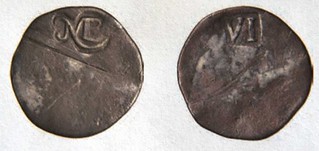 A rare Colonial Massachusetts silver coin found by an East Hampton woman in an old potato field almost 23 years ago was auctioned for more than $430,000 last week in Baltimore.
The 1652 New England sixpence had been off the market in a private collection for 21 years and was expected to sell for $100,000, but was resold for four times that price, auction officials said.
A rare Colonial Massachusetts silver coin found by an East Hampton woman in an old potato field almost 23 years ago was auctioned for more than $430,000 last week in Baltimore.
The 1652 New England sixpence had been off the market in a private collection for 21 years and was expected to sell for $100,000, but was resold for four times that price, auction officials said.
"We knew it was a very rare coin and we knew it would reach six figures," said Lawrence R. Stack, a senior numismatic consultant for Stack's Bowers Galleries, a Manhattan rare coin dealer and auction house. "And it brought in $431,250, so I guess we did well."
The auction took place at the Colonial Coin Collectors Club annual convention in Baltimore, where there were more than 200 bidders in the room, Stack said. The 360-year-old coin, one of only eight known to exist, was first auctioned for the woman who found it in 1992 by Sotheby's in Manhattan and purchased by Stack's for $35,200.
Stack's then sold it to John "Jack" Royse, 86, who decided a few months ago to put the coin up for sale, along with 102 others, because he wanted to "see them in the right hands" before he died, Stack said. The buyer is a collector who prefers to remain anonymous, Stack said.
Lillian King unearthed the coin using a metal detector in 1990 during one of her regular hunts through a potato field whose location she has not disclosed. King, now 65, had been searching in the frozen field with her boyfriend at the time, now her husband Ronald King, when she made the lucky find. The discovery made national news and even found a place in Ripley's Believe It or Not newspaper strip.
"It makes me think that I wished I had waited to sell it and put it away in a safe-deposit box," said King, adding she used the coin's sale profit to put a down payment on her East Hampton home, bought in 1992. "But I am very happy for whoever bought it. It was a priceless object."
The New England sixpence, one of the first coins minted in the colonies, was commissioned by the Massachusetts Bay Colony. Its design was altered quickly because it was easy to counterfeit. Other similar coins are in museums such as the American Numismatic Society in Manhattan, the British Museum, the Massachusetts Historical Society and the Newman Money Museum at Washington University in St. Louis -- and others are held by private collections.
"In the colonies, they were trying to make it easier for commerce to happen," said Stack, adding the sixpence is roughly the size of today's nickel. "As the society evolved, they needed a currency."
Stack said the coin was minted just three decades after the original Thanksgiving was held between the pilgrims and American Indians in Plymouth, Mass., in 1621.
"The coin is about as Thanksgiving as it gets," Stack said. "Back then, they probably bartered, 'My coin for your turkey.' "
To read the complete article, see: Rare Colonial coin found on LI sells for $430G (www.newsday.com/long-island/rare-colonial-coin-found-on-li-sells-for-430g-1.4253448)
BURIED TREASURE, UNBURIED
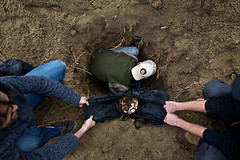 The tale began in 2009, when two men from Brooklyn, Vincent Bova and Damien Eckhardt-Jacobi, hid a chest filled with 10,000 one-dollar coins and released eight videos featuring Muppetlike creatures playing pirates who dropped hints about where the loot was. Mr. Bova and Mr. Eckhardt-Jacobi said that whoever found the money could keep it.
The tale began in 2009, when two men from Brooklyn, Vincent Bova and Damien Eckhardt-Jacobi, hid a chest filled with 10,000 one-dollar coins and released eight videos featuring Muppetlike creatures playing pirates who dropped hints about where the loot was. Mr. Bova and Mr. Eckhardt-Jacobi said that whoever found the money could keep it.
Despite the best efforts of treasure hunters who searched for almost three years, no one did.
“We definitely didn’t make it easy,” Mr. Bova said. “I had the feeling it would take time for somebody to find it, and from what I’ve seen on the Internet, people got close.”
After Hurricane Sandy devastated communities not far from their own Brooklyn neighborhoods, Mr. Bova and Mr. Eckhardt-Jacobi decided the money in the ground could be put to better use, and made plans to donate the coins to a group in Far Rockaway, Queens.
Digging up the booty was trickier than it would have been before the hurricane, because the storm had remade the landscape in the woods where they had stashed it. Some of the trees and trails that figured in the video clues were gone, Mr. Bova said. And that was before he took a couple of wrong turns and had to do some backtracking.
Spoiler alert: The next paragraph will tell where the treasure lay untouched even as some dismissed the project as a hoax.
It was next to Floyd Bennett Field in southeast Brooklyn, not more than 300 yards from a parking lot now used by National Guard soldiers assigned to the recovery effort. The spot was marked not with an X but with a skull and crossbones that Mr. Bova and Mr. Eckhardt-Jacobi nailed to a tree.
Once they finally found the spot the other morning, there was the noise of shovels stabbing deep into damp soil. That was followed by the slot-machine-jackpot sound of 10,000 one-dollar coins being lifted out of the ground and poured into backpacks.
That, in turn, was followed by some huffing and grunting as the two men discovered, all over again, that 10,000 one-dollar coins weighed an awful lot.
To read the complete article, see:
Buried Treasure, Unburied for a Greater Good
(cityroom.blogs.nytimes.com/2012/11/19/buried-treasure-unburied
-for-a-greater-good/)
WORKERS STRIKE GOLD IN CALIFORNIA BASEMENT
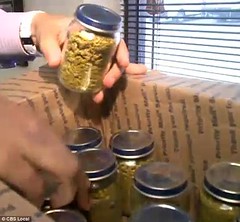 Workers struck lucky by discovering a large amount of gold hidden under the floor of a house in Sacramento - but they were honest enough to hand it over to their clients, who had no idea it was there.
Workers struck lucky by discovering a large amount of gold hidden under the floor of a house in Sacramento - but they were honest enough to hand it over to their clients, who had no idea it was there.
While installing an HVAC system in September, Steve Ottley and his partner came across 12 large baby food jars filled to the brim with gold dust. They gave the hoard to the homeowners and it has since been valued at around $300,000.
No one yet knows who left the stash behind or why it was abandoned. The owners of the house, unaware they had been sitting on such a treasure, declined to be interviewed about their windfall.
They will certainly feel they got a good deal on their home improvement - the job which cost them around $6,500 brought a 'rebate' worth nearly 50 times that amount. A surprised Ottley told CBS Sacramento of the moment he made the discovery: 'I looked at it and said, "I think that’s gold".'
The heating engineer was right - and he still has not got over his shock. 'I still can’t believe it today. It’s unreal. We kind of just looked at each other and said "wow",' he explained.
Ottley admitted that he had been tempted to take the gold himself for a second. But having been the victim of theft in the past, he realised the right thing to do was to give it to its owners, and his honesty was applauded by his boss.
'The money wasn't ours to keep and I don't believe you get a chance very often to do something radically honest, to do something ridiculously awesome for someone else and that is a lesson I hope to teach to my children,' Ferrin said.
To read the complete article, see:
Honest workers uncover mystery $300,000 gold stash hidden under floorboards... and hand it over to grateful homeowners
(www.dailymail.co.uk/news/article-2237903/Honest-workers-uncover
-mystery-300-000-gold-stash-hidden-floorboards--hand-grateful-homeowners.html)
ODORS LEAD POLICE TO COUNTERFEITERS
It's not every day the nose leads investigators to an apparent counterfeit ring, but that's apparently what happened for police at a hotel Sunday night.
It began as a simple response by the Baton Rouge Police Department to a strong odor coming from one of the rooms at the Comfort Inn on Constitution Avenue, but now, the US Secret Service is assisting BRPD into the investigation of what appears to be a counterfeit operation.
A call to a Baton Rouge hotel room for noise and smell disturbances quickly turned into so much more for police. According to police documents, hazardous materials (haz mat) units and officers discovered a white powder substance located throughout the room.
To read the complete article, see: Odors lead police to possible counterfeiting ring (www.wafb.com/story/20142403/odors-lead-police-to-possible-counterfeiting)
BANKNOTE COUNTERFEIT ZINFANDEL WINE
Michael Sullivan writes:
Numismatic Oenophiles - there is finally a wine for you: Banknote Counterfeit Zinfandel 2009. I purchased a couple of bottles at my local wine shop for experimentation. Their website (banknotewines.com) lists other offerings. While the "review" suggests it is an easy drinking wine, the bottle I opened was a "bit rough, heavy, without finesse." However, for a mere $20 it is worth considering a "counterfeit." They do get credit for one of the more interesting labels on the shelf - see photo.
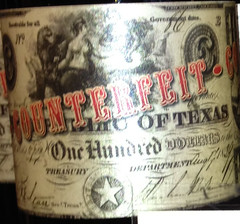

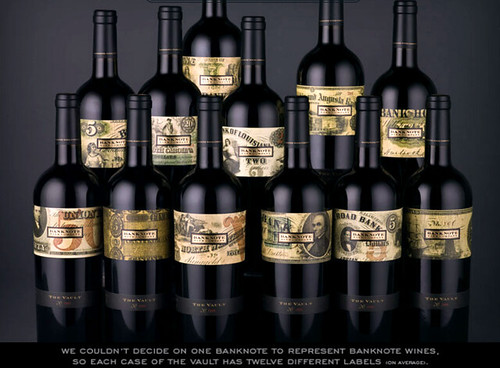
SANTIAGO MONTOYA'S MONEY-INSPIRED ART
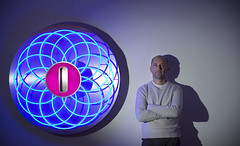 There's a lot of cash at stake in 'The Great Swindle', Santiago Montoya's exhibition at London's Halcyon Gallery. And not simply because the Colombian artist's vast canvases - portraying the revolutionaries who stare out somberly from banknotes and the sublime landscapes printed on the flipside - are likely to resonate with collectors.
There's a lot of cash at stake in 'The Great Swindle', Santiago Montoya's exhibition at London's Halcyon Gallery. And not simply because the Colombian artist's vast canvases - portraying the revolutionaries who stare out somberly from banknotes and the sublime landscapes printed on the flipside - are likely to resonate with collectors.
Money is the canvas in most of his works, impressed with machine-like repetition onto blocks of stainless steel or looped through slots in the metal like wads stuffed dubiously into a suitcase.
To amass it all, Montoya traded with currency collectors the world over, even travelling to India to secure cases of rupees, renminbi and old North Korean won, some discontinued, some still in play.
As a result, says Montoya, 'the money has been built into the value of the art'.
The banknote-canvases put into sardonic perspective the tenuous relationships between superpowers like Britain, China and Venezuela. In 'Money Talks', for instance, Montoya arranges the American and Chinese currencies in spellbinding contrast so from a distance they appear to spell out 'blah'.
'So Be It', a play on the word 'Soviet', is a grid of rubles featuring the churches in Red Square - powerful Soviet icons despite their disdain for religion.
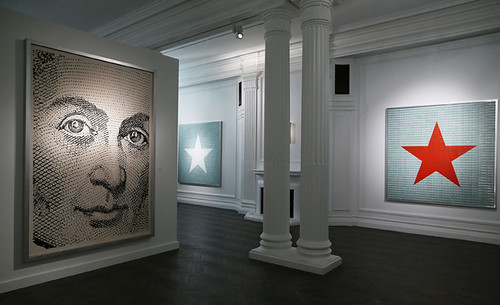
To read the complete article, see:
'The Great Swindle' by Santiago Montoya at London's Halcyon Gallery
(www.wallpaper.com/art/the-great-swindle-by-santiago-montoya-at
-londons-halcyon-gallery/6192)
FEATURED WEB PAGE: THE ENIGMA OF "LIMA"
Since last week's Featured Web Page was an article on Harry Mernick's site by Jim Duncan about the VIGO privy mark, I thought I'd follow up with Jim's companion article on the LIMA privy mark.
Having dealt with the mystery and perhaps myth of "VIGO" it seems pertinent to look at the other privy mark of the times - "LIMA".
Peter Seaby ... says "In 1745 a great treasure of silver coin had been seized in the North Atlantic by two British privateers, the Duke and the Prince Frederick, from two French treasure ships that had come from Peru. This booty was transported in forty-five wagon loads from the port of Bristol to the mint in London. As the booty principally consisted of 'piece of eight' bearing the Lima mintmark it was requested that coins taken from these prizes might bear the name 'Lima' to celebrate the exploit."
The coins which bear the 'LIMA' privy mark are gold 5, 1 and ½ Guinea pieces; plus silver Crowns of 1746, Half Crowns of 1745, 1746/5 and 1746, Shillings of 1745, 1746/5 and 1746, and Sixpences of 1745 and 1746. All from the reign of George II.
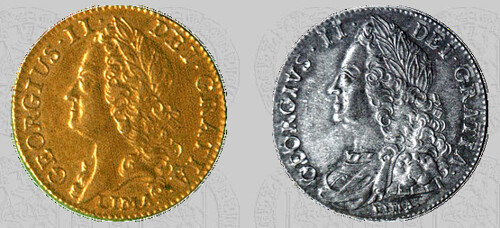
www.mernick.org.uk/lnc/talks/lima.htm

